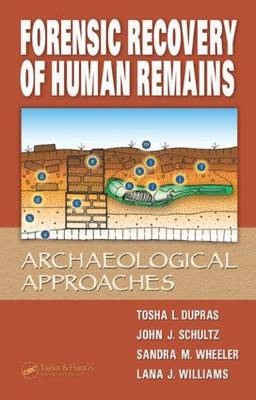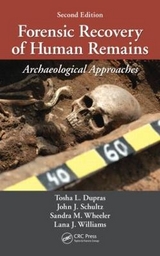
Forensic Recovery of Human Remains
Crc Press Inc (Verlag)
978-0-8493-2982-1 (ISBN)
- Titel erscheint in neuer Auflage
- Artikel merken
An essential reference for both forensic experts and non-experts alike, Forensic Recovery of Human Remains: Archaeological Approaches is a comprehensive guide that
focuses on the practical aspects of excavating and recovering human remains, along with any associated evidence, from crime scenes. It highlights the protocols and techniques that are used to successfully survey, map, recover, document, collect, and transport such items from these locations.
Topics include identifying the difference between forensic archaeology and anthropology; employing the correct equipment when conducting searches, recoveries, and excavations; leveraging geophysical technologies used in forensic searches; collecting botanical and entomological evidence; mapping and documenting scenes; and classifying human and nonhuman skeletal remains.
The authors present this information in a thorough yet straightforward manner for those who are experienced in the field of forensic recovery and for those who may not yet be as seasoned. In either situation, if you want to be confident that you have uncovered and carefully processed every bit of potential evidence at the scene, then Forensic Recovery of Human Remains: Archaeological Approaches is the one reference to have with you every time.
AN INTRODUCTION TO FORENSIC ANTHROPOLOGY AND FORENSIC ARCHAEOLOGY
What Do Forensic Anthropologists Do?
What Do Forensic Archaeologists Do?
Where Are Forensic Anthropologists and Forensic Archaeologists
Employed?
How to Find a Forensic Anthropologist or Forensic Archaeologist
TOOLS AND EQUIPMENT
Search and Site Preparation Equipment
Field Excavation Equipment
Mapping and Measuring Equipment
Drawing and Recording Equipment
Optional Equipment
SEARCH TECHNIQUES USED IN LOCATING HUMAN REMAINS
Types of Search Areas
Planning the Search
Other Recommendations for Visual Searches
Briefing Team Members Prior to a Search
Indicators to Look for When Searching for Burials and Surface
Remains
Cadaver Dogs
Intrusive Search Methods
Shovel Testing and Shovel Shining
Forensic Backhoe
GPR AND OTHER GEOPHYSICAL SEARCH TECHNOLOGIES
Ground-Penetrating Radar
Conductivity Meters
Resistivity Meters
Magnetometers
Metal Detectors
Magnetic Locators
Side-Scan Sonar
How to Find a Consultant for a Geophysical Survey
THE COLLECTION OF BOTANICAL AND ENTOMOLOGICAL EVIDENCE
Forensic Botany
Forensic Entomology
SURVEY AND MAPPING TECHNIQUES
Scales for Recording Data
Accuracy in Recording Data
Transit Survey Systems
Compass Survey
Selecting a Framework for Mapping
Global Positioning Systems
Photograph and Map Resources
THE APPLICATION OF FORENSIC ARCHEOLOGY TO CRIME SCENE INVESTIGATIONS
General Principles of Archaeology
Process of Burial
Description of Burials
Position and Orientation of the Body
Archaeological Approaches to Recovering Human Remains
Packaging and Storage of Human Skeletal Remains
Recovery of Fleshed Remains
Recovery of Juvenile Remains
Recovery of Burnt Remains
FORENSIC ARCHAEOLOGICAL CASE STUDY
IDENTIFICATION OF HUMAN REMAINS
Typical Skeletal Terminology Used in Forensic Reports
Basic Adult Human Skeletal Biology
The Subadult Skeleton
Human Dentition
DISTINGUISHING NONHUMAN SKELETAL REMAINS
Distinguishing Humans from Other Mammals
The Bird Skeleton
The Reptilian Skeleton
The Amphibian Skeleton
The Fish Skeleton
Nonhuman Animal Bones Commonly Confused with Human
Bones
APPENDICES
Appendix 1: Basic Equipment Checklist
Appendix 2: Entomology Kit Checklist
Appendix 3: Entomology Notation and Collection Checklist
Appendix 4: Entomology Specimen Log Sheet
Appendix 5: Entomology Data Form (After Byrd, 2001)
Appendix 6: Entomological Preservation Solutions (Terrestrial)
Appendix 7: Measurement Equivalents and Conversion Factors
Appendix 8: Hypotenuse Table for Constructing Grids
Appendix 9: Checklist Adult Skeletal Inventory Form
Appendix 10: Adult Skeletal Inventory Image
Appendix 11: Juvenile Skeleton Inventory Image
GLOSSARY
REFERENCES
INDEX
| Erscheint lt. Verlag | 23.8.2005 |
|---|---|
| Zusatzinfo | 22 Tables, black and white; 140 Illustrations, black and white |
| Verlagsort | Bosa Roca |
| Sprache | englisch |
| Maße | 156 x 234 mm |
| Gewicht | 499 g |
| Themenwelt | Geisteswissenschaften ► Archäologie |
| Studium ► 2. Studienabschnitt (Klinik) ► Rechtsmedizin | |
| ISBN-10 | 0-8493-2982-5 / 0849329825 |
| ISBN-13 | 978-0-8493-2982-1 / 9780849329821 |
| Zustand | Neuware |
| Haben Sie eine Frage zum Produkt? |
aus dem Bereich



